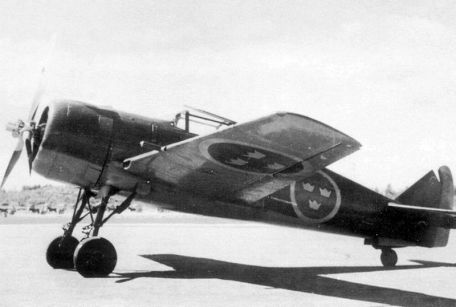FFVS J22 History
In September 1939, when another world war broke out in Europe, European powers scattered in search of viable modern weapons. This was demonstrated by Sweden, which remained neutral during a major conflict as it tried to replenish its outdated stock of fighter jets.
There are some short-term solutions to secure several U.S. designs, and more fighters were obtained through the agreement with Italy, but a better long-term design is needed, as the purchase of foreign models was quickly replaced by increased wartime commitments. Proof is impractical - if not impossible.
This prompted the Swedish authorities to build a brand new manufacturing facility that would produce a new locally sourced design - the "J22". The factory received the label Kungliga Flygforvaltningens Flygverkstad i Stockholm, abbreviated "FFVS", and the design was directed by Bo Lundberg.
The result is a single-seat, single-engine fighter with all modern qualities - closed-frame cockpit, monoplane wings, retractable landing gear, etc. The building contains a steel structure with a plywood skin. Overall, the design at the time was very traditional, with the nose supporting the engine mounts, the cockpit at the rear, the fuselage tapering aft and containing a single-stern fin. Wing main aircraft are low-mounted appendages, generally straight in shape, with truncated tips. An unlicensed Pratt & Whitney R-1830 "Twin Wasp" engine (SFA STWC-3G 14-cylinder air-cooled radial) was selected to power the model and was used in a three-bladed propeller setup (large aerodynamic trimmer) ) drive is mounted on it).
Armament includes 2 x 13.2mm heavy machine guns and 2 x 7.9mm medium machine guns.
The first flight of the prototype took place on 20 September 1942 near the FFVS factory (Bromma airfield). After completing the necessary testing, evaluation and certification, it was adopted by the Swedish Air Force under the code name J22.
The original production model - 143 of which were built - was called the J22-1.
From this work formed another major variant - the J22-2 - which carried a barrage of 4 x 13.2mm heavy machine guns and significantly increased firepower. 55 of this model were purchased. The brand boasts a top speed of 360 mph, a range of up to 790 miles and a service ceiling of 30,500 feet.
The S22-3 was an offshoot of the J22-1 fighter, modified for reconnaissance missions, although only nine were produced in 1946 and eventually returned to its fighter standard in late 1947.
The J22 in its original fighter form reached operational status in October 1943. From 1942 to 1946, the production of the 198 series consisting of the two brands mentioned above was completed. During his service, the guy was highly respected, showed good handling, and when judged directly, he was pretty good compared to his contemporaries.
Without the supercharger, however, it performed worse above 16,000 feet.
Due to Sweden's neutrality during the war and the fact that the conflict never spread to Swedish soil, the J22 was destined to never see direct combat action by the Swedish Air Force. It wasn't until 1952 that the line was scrapped and the product was never exported, it kept flying in Swedish colours.
A few samples were kept for the museum, but the series became one of many overlooked WWII fighter designs.
FFVS J22 Specification
Basic
Production
Roles
- Fighter
Dimensions
7.8m
32. 81 feet (10 m)
3.6m
Weight
2,020 kg
2,835 kg
Performance
PERFORMANCE
357 mph (575 kph; 310 kts)
30,512 feet (9,300 m; 5. 78 miles)
789 miles (1,270 km; 686 nm)
ARMAMENT
4 x 13. 2mm M/39A (Browning M2) heavy machine guns
VARIANTS
J22 - Base Series Designation
J22-1 - Initial production model; mixed armament of 2 x 13. 2mm HMG with 2 x 7. 9 MMG; 143 examples produced.
J22-2 - Armed with 4 x 13. 2mm HMGs; 55 examples produced.
J22-3 - Reconnaissance variant of 1946; nine examples modified from J22-1 stock; reverted to fighter standard in 1947.





